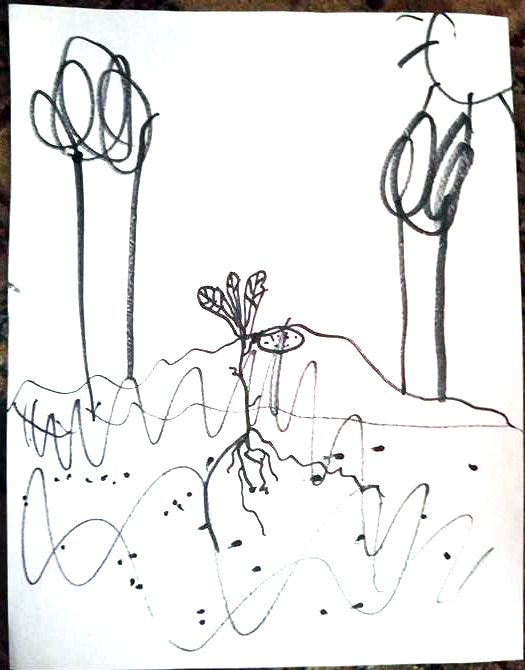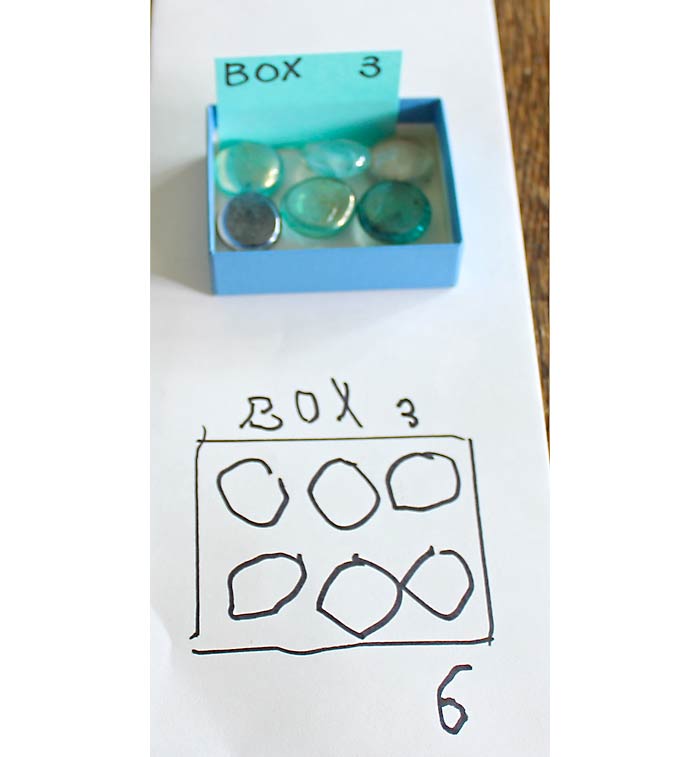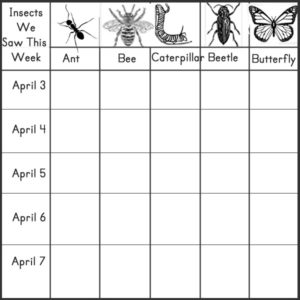While walking with my granddaughter, we spotted a small, shiny plant growing in the bark mulch under the slide at a playground. We looked at its bright green leaves shaped like the waves of the ocean, and she asked me what it was. I told her it was a seedling oak tree, and after a conversation about whether the little tree would get trampled when more children came to play, we decided to move it. She found a safer spot and we dug a hole with sticks.

The first thing she focused on as we scraped the bark mulch out of the way, was the acorn shell, still attached to the roots of the little tree. It inspired many questions. What’s that round thing? Why is it there? How did the tree come out? Will it fall off?
Even though she’d been told acorns grow oak trees, that she’d previously listened to stories about the topic, and that she’d come home with completed Autumn worksheets about the process, the book and paper and pencil activities did not come close to the wonder and learning she experienced from actually seeing an acorn sprout a tree, from feeling the soft hair roots, from the amount of digging it took to finally unearth the end of the tap root.
Having actual sensory experiences with the seedling was a meaningful learning activity. Later, when we returned home, I asked her to draw what she remembered about the seedling and she produced a detailed drawing, including the acorn, the tap root, and the root hairs, all bits that we had touched and talked about earlier (image above).
As I’ve mentioned in previous posts, I question the value of giving worksheets to primary children. If the worksheets are replacing oral language, problem-solving, creativity and sensory experiences, with pictures to color and words to copy, how much learning is taking place?
On the other hand, if the worksheet is more of a recording sheet, a place for children:
- to record their ideas, observations, and experiments,
- to try out new vocabulary,
- to record the results of their sorting or classifying,
- to draw and label their collections, well that’s different and wonderful.
Teaching Without Worksheets
Moving away from using worksheets and towards more hands-on experiences can be overwhelming when you have 20+ students in your class or you’ve never experienced teaching without worksheets. Try the following three tips to help you on your way.
1. Use the idea of the worksheet for a hands on experience
If you are accustomed to using a unit of worksheets to teach a topic, such as “Signs of Spring”, don’t throw the book out. Scan the table of contents to see what content and skills it’s covering. Look at one of the worksheets and ask, ”How can I use the idea behind this worksheet to create a more meaningful lesson?”
For example, a worksheet may have a picture of a branch with blossoms for the kids to color and a line for them to print the word blossom under it.
A more interesting experience for the children would be to bring a number of budding branches into the room and have the children observe them, smell them, feel the branches and buds and share what they’ve learned with a partner.
They can then draw their observations, record or stamp the date and label parts of their picture by sounding out words, such as “buds or blossoms”.
Place the branches in water, then a week or two later, when the blossoms have bloomed, have them repeat the activity and compare their two pictures.
2. Ask – Is this worksheet the best way for my students to practice this skill?
A worksheet where children are asked to count and record, “how many birds’ nests are in each row” is giving them the sensory experience of feeling paper and pencils, a counting experience, and a printing numbers experience.
But is it necessary to practice counting and recording with a themed worksheet just because you’ve been learning about Spring?

A bucket of polished stones and varied sizes of small jewelry boxes and lids will give the same skill practice, but one in which the children can feel the pebbles while they count and also develop volume and spatial skills. The students can be asked to find out how many stones fit in each box.
Provide paper or booklets, markers, and numbers to copy if number formation is still being learned. To record their answers, a child might trace each box on his paper, draw the stones, then count and print the number beside the box tracing. A child’s progress can be recorded as you walk around the students and jot down their accuracy on a checklist.
3. If the worksheet is requiring children to show what they know about a topic, find a different more creative way for them to do this.
The worksheet below is a common activity for primary children. It might keep children busy for 10 or 15 minutes and their experiences might be:
- Sensory – Feeling the hardness of scissors and the stickiness of glue and maybe the feeling of a crayon rubbing against paper
- Making choices about which pictures are, and are not, a sign of Spring
- Participating in the activity of cutting and gluing
Hopefully, besides being introduced to the concept of Spring with interesting picture books, the children have already taken trips outside, shut their eyes and breathed, observed aromas, breezes, and have actually searched for signs that Spring is on its way.
More meaningful experiences to communicate their knowledge about signs of Spring, and of what was significant to them when they went outside might be:
- Students create a classroom mural with all children contributing labeled, cut out drawings
- Students design and create individual dioramas, created with shoe boxes and bits of construction paper
- Small groups of students make quick stick puppets and put on a show, with each one telling about a sign of Spring
- Students work together to fill in a Venn diagram on chart paper, showing clothes they wear in winter and clothes they wear in spring or activities they can do in winter and activities they can do in Spring.
- Students plant quick growing bean seeds for a window sill garden and keep track of their growth with Unifix™ blocks and record it in individual booklets.
- Students report on insects they have discovered outside and record them on a class graph such as the one in the image below.
- Keep it simple, just:
- Make the graph quickly with easy drawings on a sheet of chart paper
- Sound out the names of the insects with the students’ help
- Don’t worry about straight lines or perfect alignment, the kids won’t care!
- Students can print their names in the boxes or stick on preprinted name labels or just put a tally mark if they have had prior experiences doing that
- Use the graph for counting practice, comparing, fewer or more
- At the end of the week, count how many ants (or bees or beetles) all together…
The question to ask is…
What experiences are my students actually having when I give them this specific worksheet?
An Easy Introduction
If replacing worksheets is overwhelming to you or if you feel less than confident about the process, you may find my ebook, Challenging Children to Investigate With Everyday Things, a great introduction.
You’ll learn how to use common objects for learning experiences and how to get organized for simple weekly lessons. And best of all, if you’re just starting out, you’ll find 39 detailed activities with 50 recording sheets to start you on your way. If you’re interested, check it out here…

